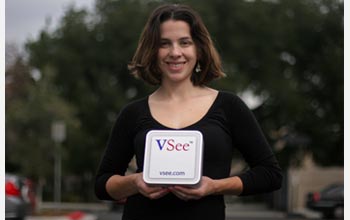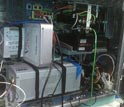News Release 09-017
Keeping an Eye on the Inauguration
New system enabled law enforcement to monitor security cameras all at once, even from police cruisers

Colleen Beeson of VSee holds the hardware component of their virtual office system.
February 4, 2009
View videos of Milton Chen, chief technology officer at VSee, and Errol Arkilic, program manager in NSF's Division of Industrial Innovation and Partnerships.
This material is available primarily for archival purposes. Telephone numbers or other contact information may be out of date; please see current contact information at media contacts.
One of the toughest technological challenges for law enforcement is to simultaneously monitor live feeds from the wireless cameras scattered across their jurisdictions. A nearly impossible task under any circumstances, it was an even greater one for Barack Obama's Presidential Inauguration.
In planning to safeguard the millions of visitors and residents in the city for the Inauguration events, Washington, D.C. required a new surveillance approach.
In response, law enforcement adapted a "virtual office" system called VSee to overcome the bandwidth obstacles that had prevented simultaneous access to all of the city's cameras.
Developed with National Science Foundation (NSF) support as part of the Small Business Innovation Research Program, VSee is a combination of hardware and software that allows users to securely receive and share large amounts of information, usually within a virtual office environment.
Though originally created as a telework platform, VSee was adapted to enable security officers to watch multiple remote cameras in real time from a single command center. Because the changes to the system shrank the cameras' data-streaming bandwidth to a fraction of its original size, even police cruisers were able to access the feeds via cellular networks.
The technology originally emerged as the Ph.D. work of Milton Chen, then at Stanford University, where he focused on videoconferencing and remote collaboration. "After I completed my Ph.D., my advisors and some of my colleagues who worked on the project decided to form VSee with me," says Chen.
Not satisfied with existing virtual office approaches, Chen wanted to find a way to capture the advantages of telework without the usual technical shortfalls and impact on office social dynamics--both burdens on productivity. Even today, with the support of funds from NSF and other sources, Chen and his team modify the software based on findings from research studies of the social dynamics of both the workplace and home work environments.
Existing collaboration tools limited the remote work experience in significant ways, with handicaps including difficulties sharing on-screen applications, limited webcam feeds and poor video, which can cloud the critical social cues necessary for remote communication.
"From a technology standpoint, what resonated most with NSF was the clever bandwidth-management enabled by VSee's approach," says Errol Arkilic, the NSF program officer who oversees VSee's grants. It was the bandwidth management that made the Inauguration monitoring possible. "VSee engineered a solution that bypasses the constraints of various communications protocols, a breakthrough that has the potential to span across many platforms, including wireless."
Within the remote-work system that Chen and his collaborators developed, all users can clearly see each other at once, work together on an on-screen document or other object, and trust that their environment is secure from intruders. And unlike a virtual meeting, the VSee platform is on all day, with options for privacy, so it becomes a true virtual office environment.
For the Inauguration application, the interface was the same, with each camera taking the role of a "user". With VSee managing the bandwidth, for the first time, security officials could keep all cameras active and bring real-time situational awareness to law enforcement officers wherever they were in the city.
VSee also solved the key problem of inter-agency collaboration. During the Inauguration, VSee was used by half a dozen law enforcement agencies to share information and collaborate in real-time.
While security applications are still new, the system's adoption for telework has expanded rapidly since its release in 2003, with several Fortune 500 companies and federal agencies adopting VSee for remote work or for traceless, secure collaborations.
The employees at VSee are continuing to refine their software, modifying it as they use it for their internal use in offices around the world. Says Chen,"By focusing on the collaboration requirements of a team like ours, we aim to create a simple tool to achieve the productivity of a bullpen in a tech startup."
-NSF-
-
View Video
Milton Chen of VSee explains how the system works and how it differs from existing applications.
Credit and Larger Version -
View Video
Errol Arkilic describes the VSee technology and role of federal investments for small-business R&D.
Credit and Larger Version -
The employees at VSee use the application for their own multi-national telework environment.
Credit and Larger Version -
The VSee hardware is shown as it appears installed within a security system.
Credit and Larger Version
Media Contacts
Joshua A. Chamot, NSF, (703) 292-7730, email: jchamot@nsf.gov
Program Contacts
Errol B. Arkilic, NSF, (703) 292-8095, email: earkilic@nsf.gov
Principal Investigators
Milton Chen, VSee, (650) 400-1798, email: milton@vsee.com
The U.S. National Science Foundation propels the nation forward by advancing fundamental research in all fields of science and engineering. NSF supports research and people by providing facilities, instruments and funding to support their ingenuity and sustain the U.S. as a global leader in research and innovation. With a fiscal year 2023 budget of $9.5 billion, NSF funds reach all 50 states through grants to nearly 2,000 colleges, universities and institutions. Each year, NSF receives more than 40,000 competitive proposals and makes about 11,000 new awards. Those awards include support for cooperative research with industry, Arctic and Antarctic research and operations, and U.S. participation in international scientific efforts.
Connect with us online
NSF website: nsf.gov
NSF News: nsf.gov/news
For News Media: nsf.gov/news/newsroom
Statistics: nsf.gov/statistics/
Awards database: nsf.gov/awardsearch/
Follow us on social
Twitter: twitter.com/NSF
Facebook: facebook.com/US.NSF
Instagram: instagram.com/nsfgov




